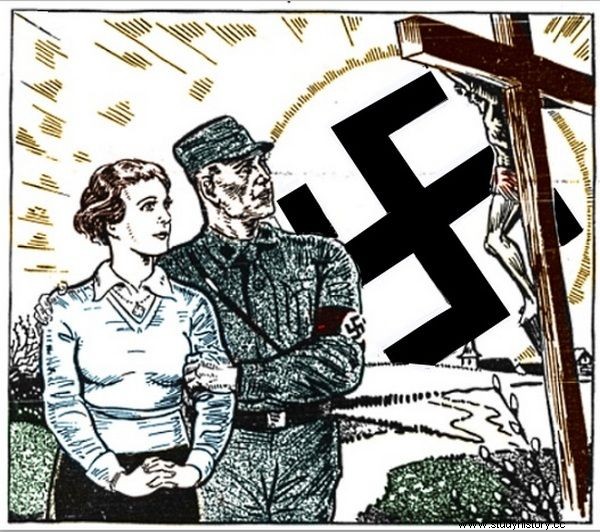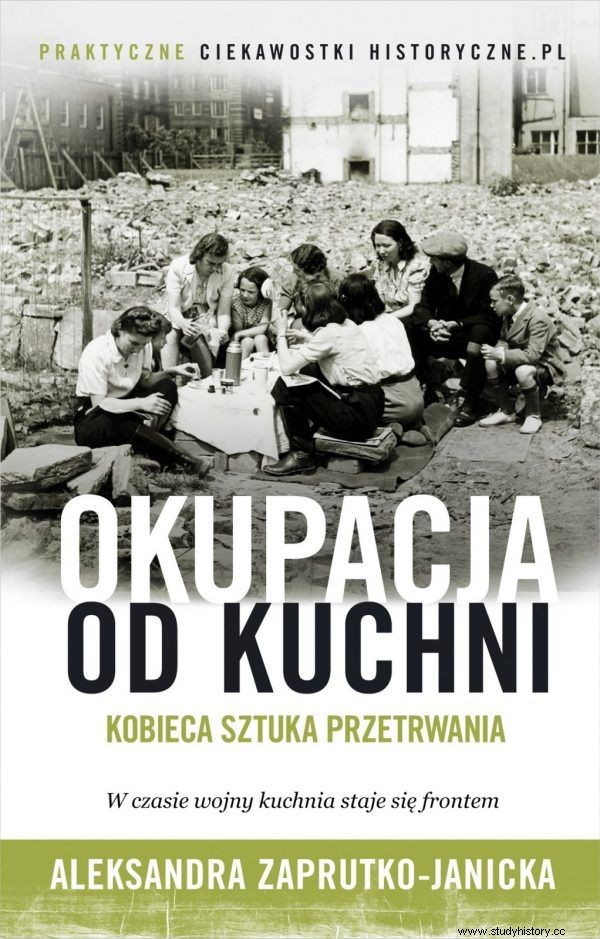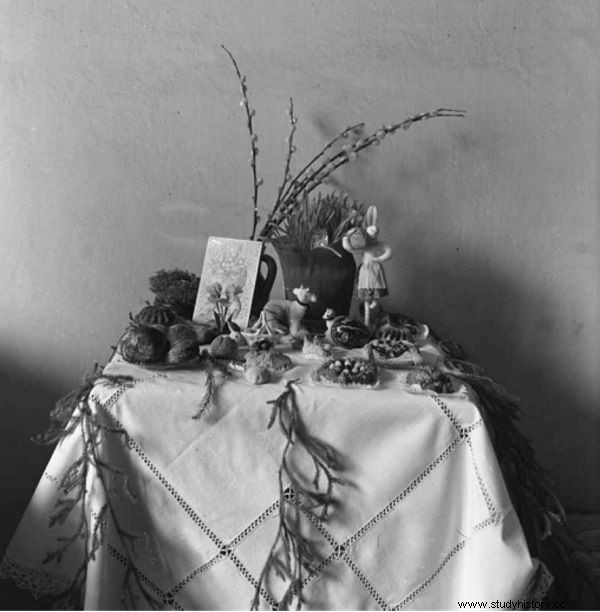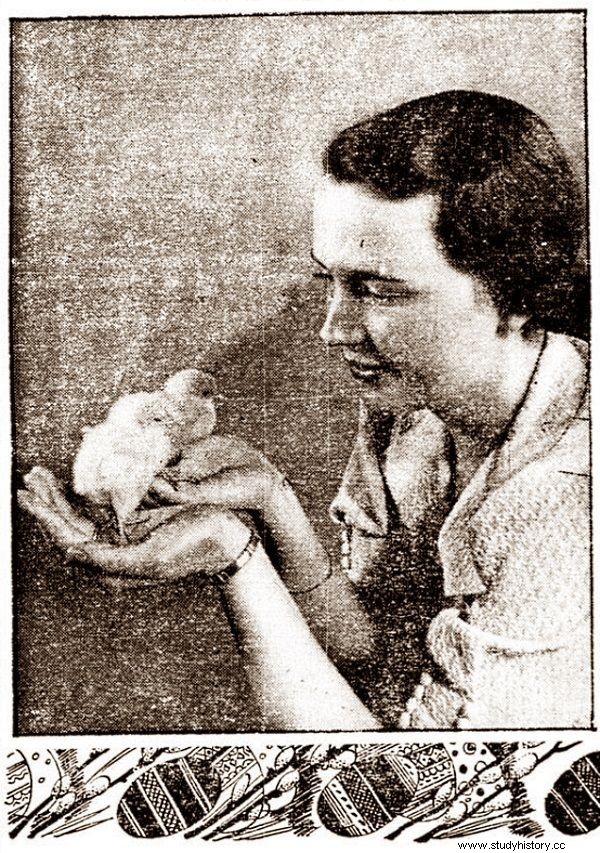Can you imagine Easter without eggs, sour soup and sugar lamb? It's still nothing. Many families sat down to the ceremonial breakfast without their loved ones who died at the hands of the Germans. In addition, for a piece of meat bought on the black market for the festive table, they were in danger of death. And how can you wish for a "Happy Hallelujah"?
"I remember a peculiar Holy Saturday on Holy Saturday. Wealthy housewives placed open baskets in two rows along the church, a priest walked in the middle and blessed them, followed by hungry, dirty boys, nobody's children, war orphans and remembered where the most eggs and cured meats were "- recalled Kazimiera Toniak from Hrubieszów.
The future diarist was only a five-year-old girl in September 1939. She did not understand much about war and German bestiality, but the inequalities in the occupation society were a matter of course for her. She continued:
Then the women placed their baskets in front of St. Anthony, and they themselves went to pray to the tomb of Christ. At that time, the boys were grabbing the heaviest baskets, escaping with them into the bushes to the river and celebrating Easter there. There was so much screaming and confusion when the owners of the baskets could not believe that someone might have stolen them from the church. If they saw these 10-12 year old ragged boys, they would probably forgive them. Just like Saint Anthony, who did not take care of the baskets ...

Occasional Easter graphics printed in "Nowy Kurier Warszawski".
Among the women who seemed to little Kazimierz "wealthy housewives", there were probably smugglers' wives, resourceful Volksdeutsche and blackmailers. However, there were also ordinary Polish women, whose life was by no means spoiled. They struggled with hunger and poverty on a daily basis.
Due to their own children or their deep desire for normality, they once reached for blackheads or borrowed oneself to have a real Easter. Losing the Christmas basket was a real tragedy for them - and canceled out the often many weeks of preparation.
DIY decorations
As part of the latter, first of all, it was necessary to decorate the Easter table in a beautiful way. It was even more important than before the war.
Due to high prices and shop shortages, it was impossible to create a festive mood with the food itself. How did the housewives decorate the table? "Nowy Kurier Warszawski" suggested in the words of his journalist:
Few can afford showy but expensive flowers. Therefore, it is best to go on a further walk one Sunday and cut a few willow twigs. After bringing them home, put them in a jar or a vase of water, and soon they will sprout nice shoots, giving nice greenery for Christmas.
In addition to the willow, gadzinówka also recommended intricate structures made of watercress. This tiny green plant in skilful hands and with a little creativity could turn into a beautiful decoration. It was enough to soak the seeds well and sow them in good time, using a special "rack".

Graphics depicting Śmigus-Dyngus, printed on the occasion of Easter in the "Nowy Kurier Warszawski" reptile house.
It could be an inverted flowerpot covered with a wet cloth, a nice vase or other similar vessel. After sowing the cress, it had to be put aside for two weeks in a warm place. After this time, the table decorations were ready and, in addition, they could be used as an addition to salads and sauces.
Save the family budget
Before the holidays themselves, an increased movement in trade was starting. Pastries with the inscription "Happy Hallelujah" appeared in pastry shops, and Easter chickens made of yellow icing, chocolate bunnies and beautiful occasional postcards flaunted at the shop windows. For many resourceful housewives, preparing and selling Christmas baked goods was a way of repairing the household budget.
Hanna Kramar-Mintkiewicz, a citizen of Warsaw, recalled that her mother used to bake cakes, and she "helped with the distribution, especially before Christmas, of some mazurkas". For all this, however, you had to have money. Real delicacies guaranteeing Easter in a pre-war style were available only on the black market.
Whoever wanted to have Christmas with traditional dishes had to pay dearly. Most of the Polish women relied mainly on their resourcefulness. If they had given their fate fully into the hands of clandestine traders, they would have bankrupted their families in just one holiday.
Easter menu for crisis times
Holy - a ceremonial breakfast on Easter morning - was traditionally one of the most important "culinary events" of the year. Pre-war housewives rose to the heights of their culinary abilities and skills, baking new babas, mazurkas, carving lambs in butter and decorating Easter eggs. In addition, the tables were primarily cold meats, in line with the principle that you should not cook anything on the feast itself.

Many unrepentant Nazis also called themselves Christians. I wonder how they dealt with the fact that they celebrate the crucifixion and resurrection of the Jew? (source:public domain)
Pork reigned, as it is today, mainly in the form of whole baked ham and sausages, and in the most affluent households, you could also see whole-roasted piglets on the festive table. For all these delicacies, the family, friends, and if it was possible, also the priest were asked.
In the realities of the occupation, it was necessary to give up just as many meetings. The housewives, despite the most sincere intentions, did not have the opportunity to set the table with heaps of Easter eggs and traditional women who used to roast even sixty eggs.
Jerzy Duracz mentioned in one of his books that a kilo of butter during the occupation could cost 180 zlotys, and a liter of oil - 100 zlotys. These prices increased especially before Christmas, forcing people to make special savings.

The female art of survival in Aleksandra Zaprutko-Janicka's book "Occupation from the kitchen".
Just one Easter egg…
Of course, the women tried to provide at least one egg for Easter to share in the traditional way. With the rest, it was different, so it is no wonder that underground publishing houses recalled a pre-war text by Stefan "Wiech" Wiechecki devoted to Easter. The most famous singer of Warsaw folklore wrote:
First of all, an egg! It is a religious dish and it is not a good idea to choke on, a sign of this should not be stuffed with every wish, but by holding the quarters on a fork, at least two people should be served with it.
A few years earlier, this text was a satire of the stinginess of a typical inhabitant of the capital, who did not even want to share his egg with his fellow man. Now the joke turned into a sad requirement of everyday life, and allocating one egg for two people in many homes was considered to be extremely extravagant.

A table with a saint from 1944.
Meat on the festive table was not a matter of course either. In this context, the recipes for pickling it, or tricky "smoking" (giving it the right flavor and color without smoke), sound quite absurd. Likewise, dwelling on a good kneading and taking it to a bakery to bake it.
Official newspapers could imagine an idyllic vision of occupation, but our grandmothers were forced to live in this down-to-earth and real one. And I think they were just laughing under their breaths, reading in the "Nowy Kurier Warszawski" that Easter passes with the awakening of spring.
In fact, it was marked by galloping prices ... Gadzinówka also talked about the fact that due to the heat on Good Friday, people visiting God's graves bought all soda water and lemonade. And it probably was true. What if, but the complete purchase of any commodity was neither a unique nor a rare art under the occupation.

Gadzinówka tried to distract Poles from the high prices, reminding them that spring is coming and nature comes to life. Lost case - after all, it was always the hardest to feed in the pre-harvest season.
Born in 1915, Tadeusz Żakiej, who published cookbooks under the pseudonym Maria Lemnis and Henryk Vitry, perfectly remembered what it looked like in reality. In the introduction to the publication In Old Polish Cuisine and at the Polish Table described that Easter was celebrated in the shadow of rampant terror, uncertainty of life and hunger:
Sharing a traditional Easter egg was emotional. These were not meals, as they could not satisfy the hunger, but patriotic symbols helping to persevere, survive and - wait.
***
The article was based on materials collected by the author while writing the book "Occupation from the kitchen".
"Okupacja od Kuchni" is a moving story about the times when illegal pig slaughtering could lead to Auschwitz, vegetables were grown in the courtyards of tenement houses, and used coffee grounds were traded on the black market. It is also an amazing cookbook:full of original recipes and practical tips from 1939-1945.
